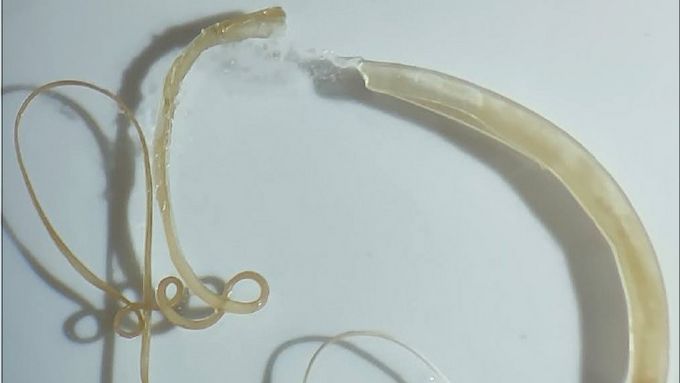Swiss TPH Officially Hands Over Newly Discovered Parasitic Worm to Natural History Museum Basel
19.06.2025
Researchers from the Swiss Tropical and Public Health Institute (Swiss TPH) and partners have discovered a new parasitic worm species named Trichuris incognita in Côte d’Ivoire during a Swiss TPH-led clinical trial. The discovery has significant implications for drug development and diagnostics, as the species is visually indistinguishable from known whipworms yet much less responsive to standard treatment. The discovery is now formally recognised through the official handover of preserved specimens to the Natural History Museum in Basel, in accordance with international scientific naming protocols.

Trichuris Incognita (Photo: Max Bär / Swiss TPH)
Whipworm infections affect approximately 500 million people worldwide, predominantly in children in low- and middle-income countries. These infections, caused by the parasitic worm Trichuris trichiura, can lead to significant health issues including abdominal pain, diarrhoea, and anaemia. Until now, it was assumed that all human whipworm infections were due to this single species.
However, researchers from the Swiss Tropical and Public Health Institute (Swiss TPH), in collaboration with partners in Côte d'Ivoire and the University of Calgary, Canada, have identified a previously unknown species infecting humans. This discovery was made during a clinical trial in Côte d'Ivoire where standard treatments with albendazole and ivermectin showed lower efficacy compared to results in Lao PDR and Tanzania.
As the species looks exactly the same as Trichuris trichiura under the microscope, researchers first suspected drug resistance. Genome analysis then revealed that patients were infected with a different until then unknown species. The new species was named Trichuris incognita by the research team in reference to its ability to remain unnoticed until now.
Major implications for drug development
“This discovery has major implications for how we treat parasitic worm infections globally,” said Jennifer Keiser, Head of the Helminth Drug Development unit at Swiss TPH and Professor of Neglected Tropical Diseases at the University of Basel. “It is possible that patients in many regions have been infected with Trichuris incognita, while our best available treatment – the combination of albendazole and ivermectin – is not effective against it. The discovery further underscores the urgent need for new therapies against these neglected tropical diseases.”
Keiser is hopeful that the new drug emodepside, which showed very promising results in recent clinical trials, may prove effective against Trichuris Incognita. Further studies will be necessary to confirm its efficacy. Swiss TPH is currently collaborating with Bayer to further develop emodepside.
Unknown global distribution
The new species has been confirmed primarily in Côte d'Ivoire. Its global distribution remains unknown, as comprehensive DNA sampling is still needed from other endemic regions. “For Côte d'Ivoire, this discovery is crucial,” said Jean Coulibaly, researcher at the Centre Suisse de Recherches Scientifiques en Côte d’Ivoire. “This finding could change how we control whipworm infections across the country – and globally.”
Official hand-over to the Museum of Natural History Basel
Today, Swiss TPH officially handed over male and female specimens of Trichuris incognita, preserved in ethanol, to the Museum of Natural History in Basel. This step is part of the formal process required by the International Code of Zoological Nomenclature to register the species.
“We are proud to archive the name-bearing type of Trichuris incognita as an invaluable part of our scientific collections,” said Christian Kropf, Head of Life Sciences at the Natural History Museum Basel. “Our collections are curated at highest standards and are available for study to all who are interested in exploring the diversity of life on our planet.”
Importance of next-generation sequencing
The breakthrough was made possible thanks to next-generation sequencing technologies, which allowed researchers to construct the whole genome of the parasite. The discovery also highlights the growing importance of next generation sequencing technologies in parasitology and diagnostics, enabling scientists to detect hidden species that traditional methods like microscopy fail to discover.
“It’s incredibly exciting to be part of this discovery,” said Max Bär, who proved the existence of Trichuris incognita in his PhD thesis. “This worm may look just like other species from the same genus under the microscope, but its genetic makeup is slightly different. And this tiny difference has considerable implications for global health.”
Contact

Jennifer Keiser
Professor, PhD
Head of Unit
+41612848218
jennifer.keiser@swisstph.ch
Stay connected
Subscribe to our newsletter and get all the latest research news, project updates, course and event listings from Swiss TPH.